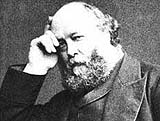Robert Gascoyne-Cecil, Marquess of Salisbury 1885-6, 1886-92 and 1895-1902 Conservative
 Born: 3 February 1830 at Hatfield House, Hertfordshire
Born: 3 February 1830 at Hatfield House, Hertfordshire
First entered Parliament: 22 August 1853
Age he became PM: 55 years, 144 days; 56 years, 172 days; 65 years, 142 days
Maiden speech: 7 April 1854, opposing the Second Reading of the Oxford University Bill
Total time as PM: 13 years, 252 days
Died: 22 August 1903 at Hatfield House, Hertfordshire
Facts and figures
Education: Eton and Christ Church, Oxford
Family: Salisbury was the third son and fifth child of six. He was married to Georgina Caroline Alderson, and had five sons and three daughters
Interests: Reading, chemistry, the study of electricity, riding a tricycle
Biography
Reserved and distant
Compared to the flamboyance of Disraeli and Gladstone, the Marquess of Salisbury was a reserved, distant figure, yet he ranks among Britain's longest-serving prime ministers.
Adopting a laissez-faire attitude to matters at home, Salisbury's main interests lay in the direction of foreign affairs, especially British interests in Africa. His other political legacy was strengthening the Conservative party by unifying different factions.
Born into an aristocratic family, Salisbury was descended from Lord Burghley, a minister of Queen Elizabeth I. A frail child, prone to depression, he developed a love of books and botany.
After gaining a fourth-class degree in mathematics from Oxford, Salisbury set out on a world tour for the good of his health, visiting South Africa, Australia and New Zealand. He returned much stronger, with a keen interest in the British Empire.
Salisbury entered the Commons in 1853 at the age of 23, as MP for Stamford.
To earn enough to support himself and his wife, he started writing political articles for journals, gaining him a reputation as a shrewd commentator.
His first political post came in 1866, when he was appointed Secretary of State for India under Lord Derby. Less than a year later, he resigned in opposition to plans to extend the electoral franchise.
In 1868 Salisbury entered the House of Lords following the death of his father, and Chancellor of Oxford University a year later. He maintained his intellectual interests, building a laboratory at Hatfield House where he experimented with electricity.
Securing peace
When the Conservatives returned to office in 1874, Salisbury became Secretary of State for India under Disraeli. Although their relationship started out stormily, it improved so much that in 1878 Disraeli appointed Salisbury Foreign Secretary.
In that role, Salisbury helped to secure peace in the Balkans at the Congress of Berlin. Salisbury took over the Conservative leadership on Disraeli's death in 1881, and reluctantly became prime minister of a minority administration in 1885.
His first administration included legislation on housing the working class, but within months an election cut short his term.
 Returning to office in 1886, his second administration was much stronger, benefiting from the Liberals' internal strife. Reforms at home included the Local Government Act of 1888, transferring the administration of counties to elected county councils, and the 1891 Free Education Act, abolishing fees for primary education.
Returning to office in 1886, his second administration was much stronger, benefiting from the Liberals' internal strife. Reforms at home included the Local Government Act of 1888, transferring the administration of counties to elected county councils, and the 1891 Free Education Act, abolishing fees for primary education.
Instead of the traditional role of First Lord of the Treasury, Salisbury unusually combined the role of the Prime Minister with that of Foreign Secretary, a demanding double job.
Under his direction, the colony of Rhodesia (today's Zimbabwe) was established, with its capital city named Salisbury. The PM's diplomatic skills were demonstrated in 1890-91 through a settlement reached with the other European imperial powers over African territories.
Well-loved
By the time he became prime minister for the third and final time in 1895, Salisbury had become a well-loved elder statesman.
Home legislation included the Workmen's Compensation Act of 1897, making the employer liable for accidents at work.
Yet there were problems brewing in the Cape Colony in South Africa. The Boer War broke out in 1899, splitting the Cabinet and leading to Salisbury's resignation in 1902. His nephew, Arthur Balfour, replaced him as prime minister.
Salisbury died in 1903 at Hatfield House, his family home in Hertfordshire.
Quote unquote
"English policy is to float lazily downstream, occasionally putting out a diplomatic boathook to avoid collisions."
Did you know?
Salisbury was the last peer to serve as PM, with the brief exception of the 14th Earl of Home who renounced his peerage within a few days of being appointed.
Wife
In 1857 Salisbury married Georgina Caroline Alderson, the daughter of a judge. It was against the wishes of his father, who deemed her of low social standing and cut back his son's financial allowance.
Georgina proved the ideal wife for Salisbury. In addition to bringing up eight children, she ran the family homes and looked after the poor on Salisbury's Hatfield estate.
She also helped to organise a ragged school near her home in London, and taught there for a time.

 PM's Biography
PM's Biography PM Record Breakers
PM Record Breakers Take a tour of Number 10
Take a tour of Number 10 Useful Links
Useful Links